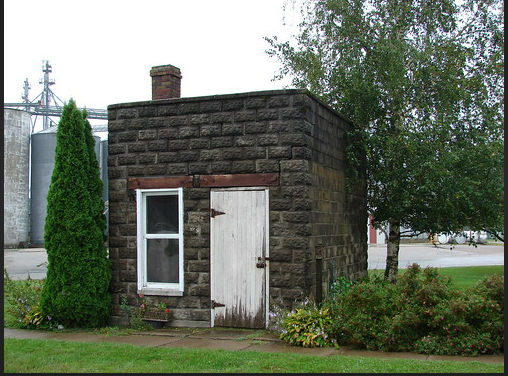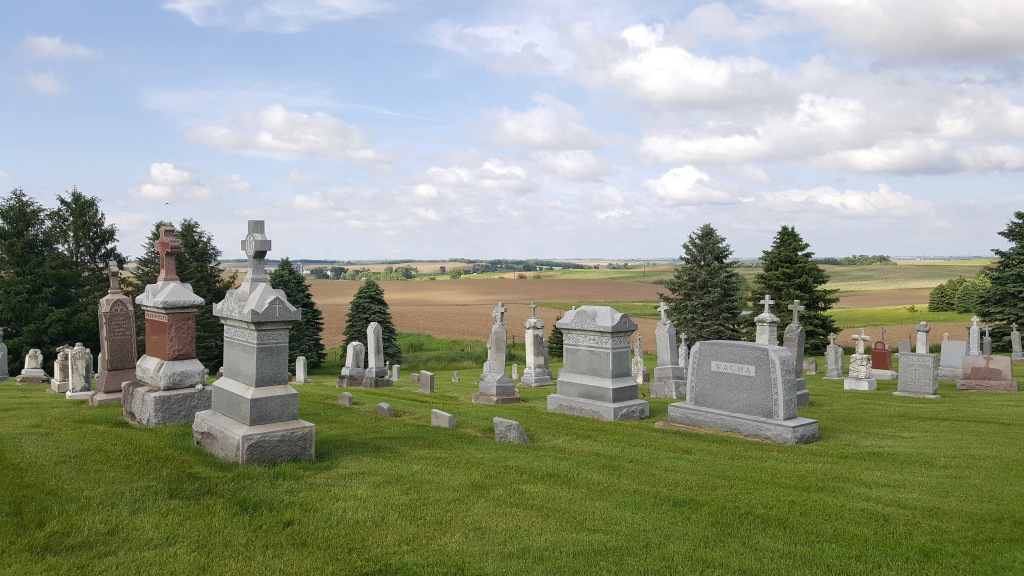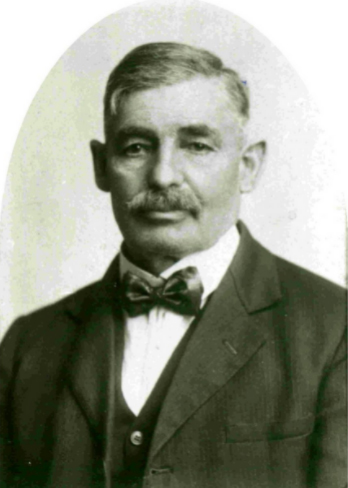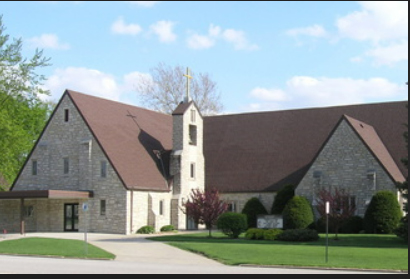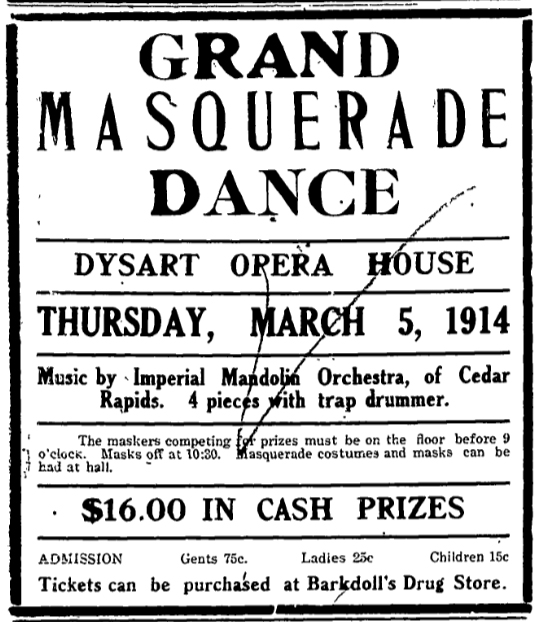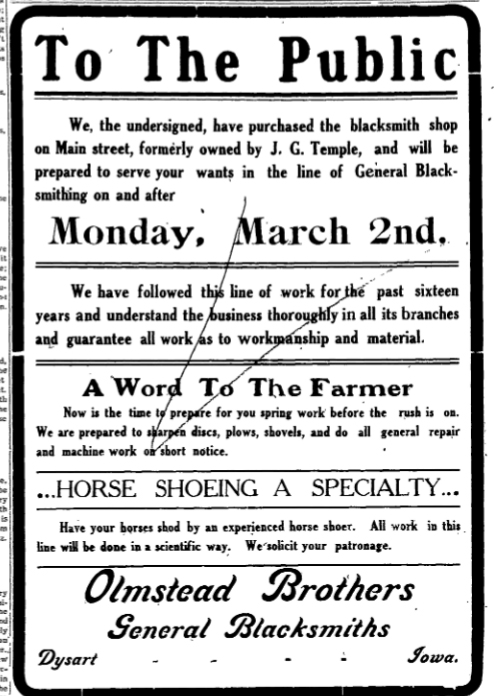The News From Dysart and North Central Iowa
First Week of March 1914
State News

Tama County's Pheasant and Quail Nursery
Traer to Get Game Preserve
SIX THOUSAND ACRES OF LAND INCLUDED
"Traer gets the game preserve of Tama County. The timber land west of town offered a very desirable spot and E. D. Sawyer and others got busy with the result that a contract was sent on by the state game warden to be signed by the property owners, with the understanding that the preserve would be located here if the lease was signed by all the owners of the land included. Mr. Sawyer has thirty or more names on the lease. These parties contract to prohibit all hunting upon their premises for five years and to protect the birds in all possible ways. The preserve will include about 6, 000 acres, much of which is covered with timber. It takes in the McEwen farm and stretches two or three miles west and north. The state will put up signs along the boundary. In April or May a large number of pheasant and probably a lot of quail will be brought here and liberated within the preserve. Great things are anticipated in the way of increased flocks with the five years. These pheasant are imported from Hungary and they multiply rapidly when protected. " Traer Star Clipper March 6, 1914.
The same week, The Dysart Reporter, ran an article that sportsmen in Boone County were also working to establish a preserve at a place called Hat Grove, halfway between Boone and Des Moines along a stream of water called the Big Creek Waters. Another game preserve was secured east of Moravia consisting of 6500 acres.
In June of 1914, the Traer Star Clipper reported that the game warden sent 120 eggs of the Chinese ring-necked pheasant to Traer which were given out to farmers in the vicinity to be hatched.
Originally an Asian species, the ring-necked
pheasant was successfully introduced into North
America in 1881 and into Iowa about 1900. Iowa’s
first ring-necks were introduced accidentally when
a severe windstorm wrecked the pens of game
breeder William Benton of Cedar Falls releasing
approximately 2,000 birds. Benton’s birds spread
north and west and constitute Iowa’s founding
stock. The DNR began stocking pheasants around
1910 with most regions of Iowa receiving large
stockings of ring-necks by 1930. The ring-neck has
since become the most important gamebird in Iowa
with an estimated statewide population of 4 to 6
million birds.
IOWA DEPARTMENT OF NATURAL RESOURCES
Editor's Note: The history of introducing pheasants to Iowa is, of course, more than can be covered in this posting. For readers desiring more information, I recommend:
THE RING-NECKED PHEASANT IN IOWA, by Allen L. Farris, Eugene D. Klonglan, Richard C. Nomsen Click to access book_ring_necked_pheasant.pdf.Iowa conservation commission

earlyaviators.com
Patent War Closes Grinnell Aeroplane
"The Wright company of which Orville Wright, the pioneer airman, is president, has served notice on the Grinnell Aeroplane Company to cease manufacturing aeroplanes. The demand is based on the recent decision of the US Circuit Court of Appeals in which it decided as an infringement against the Wright Company patents any heavier than air flying machine which uses a rudder with the wings." Dysart Reporter March 5, 1914
The Wright Company Patent Wars have been written about extensively. Many believe that this slowed the development of airplanes in the US significantly. Readers desiring more information can find many articles, podcasts, and books by searching the internet. I found this website particularly helpful in understanding the lawsuits. https://wrightstories.com/articles/patent-wars. Wright stories.com
Population Decline
"State officials are seriously discussing the loss of 15,000 men from Iowa in 1912 and 1913, as reported by Adjutant General Guy E. Logan, and many suggestions are made regarding plans to overcome the reported loss in population. The Department of Agriculture has suggested that moving pictures of Iowa should be manufactured to be exhibited. It is the idea to make the pictures entertaining and at the same time create a desire among those who see them to come to Iowa. Another idea of this department to attract people to the state is to issue booklets by counties giving the main points regarding each of the ninety-nine counties of the state. Each division of the state would be described independently of the remainder of the state, so that the booklets could be used for local as well as state advertising. The suggestion that the governor appoint a commission to study the causes of loss of population and to recommend a remedy was also made. Adjutant General Logan states that the loss of 15,000 fighting men in the last two years, or 22,000 in the last five years is a serious situation for the 22,000 represent good strong healthy men whose services are needed to build up Iowa. All of these men were between the age of 18 and 45 and were able-bodied. A loss of this many toilers represents a far greater loss than a simple falling off of the population by 22,000." Dysart Reporter March 5, 1914
Local News
Mayor of Dysart Gets Into a Very Public Fight

Dysart Reporter March 5, 1914
Trouble ensued on Monday morning when the Mayor of Dysart, Dr. John P. Redmond attempted to move into the residence of Mr. and Mrs. E.A. Braden and family. Mrs. Braden is the sister of Dr. Redmond. Last fall, the Braden's began construction of a cottage. The plan was that when the home was finished, Dr. Redmond would move into the John Redmond home where the Braden's have been living. The Braden's new house was not finished in time for the planned March 1st move. The Braden's have been living with John and Mrs. Braden's father two blocks east of Main Street for the past seven years. No notice was given to them to move
Monday morning at about 7 a.m., Dr. Redmond crossed the street to the home were the Braden's have been living carrying a large box. He was met on the porch by Braden at which time he announced his intention to move into the house that day. Braden let him know this would not be happening. Redmond had a screwdriver in his hand which he made a pass at Braden with; striking him in front of his left ear. At the same time, Braden struck Redmond, knocking him to the ground where he held Redmond until several men intervened. At that time, Redmond first attempted to use his powers as mayor to deputize the men who had come to help. Braden and his wife then left the scene and went to the hardware store. Redmond attempted to use a ball bat but this was taken away from him by the other men present. He then followed Mr. & Mrs. .Braden into the store wielding a club.
The marshal George Geyer had been called. When he arrived at the hardware store, Redmond ordered Geyer to take Braden to jail. Geyer could do nothing but obey the order. Before they left the store, Redmond refused to make out bonds for Braden and insisted he be taken to jail. This was all witnessed by several men who were in the store. Redmond then went to the gun case stating that he wanted a revolver. He was told that one would not be sold to him. Once he saw that Braden was in jail, he began moving his possessions into the house.
The excitement on the street had reached the level of white heat and a delegation of men threatened to break the jail to pieces to get Braden out. Redmond ordered Geyer to bring Braden to the office where he made out a bond ordering Braden to appear in front of the grand jury as well as a peace bond
W.J. Dysart, the justice of the peace, was consulted and ordered that the bonds were illegal and that Braden would need to be re-arrested. He was re-arrested at which time C. J. Schmidt and Ed Heineman swore out bonds for $200 promising that Braden would appear for trial. The charge was "assault and battery with the intent to do great bodily harm". To most of those present, Braden was just trying to protect his family and was unarmed when he was attacked with the screwdriver.
Even after all of that, Redmond remained determined to move into the house. About one hundred men were present by this time and Braden invited all of them into the house. With one hundred men against him, Redmond could do nothing. During the approximate half hour that Braden was in jail, Dr. Redmond had moved a bed into one of the bedrooms and put a few things into the cellar.
Redmond called Dr. Carl from Garrison to come and tend to his wounds. Dr. Carl arrived about 10:30 p.m. and performed an examination. Several stories are circulating about the extent of his injuries. The incident occurred on Monday and as of Thursday, Dr. Redmond was still in bed. Dr. Gessner tended to Braden's injuries. The wound in front of his ear was about one-half inch deep and lay right over a large artery which if severed would have been much more serious.
A trial will be held on Friday. This will be a jury trial and the judge will be W.J. Dysart. M. J. Tobin of Vinton has been hired to represent Braden. Sentiments are running high in support of Braden. Most feel that Redmond had no right to start the trouble. His efforts to deputize spectators was poorly received. Recently, Braden had inquired about legal procedures to force a man to vacate a dwelling and he found that a family having a notice served on them has 38 days to get out. Braden had not received such a notice. Redmond had received notice that he was to vacate the property he was occupying but Dave Wilson was not pushing him to move out. In fact, he understood that Redmond would not be able to move until the Braden's had moved out.
"The Gene Braden trial which was to result from the trouble which arose between Dr. J.P. Redmond and Gene Braden on Monday of last week did not take place for the reason that no one appeared against Braden. Dr. Redmond states that he was not informed of the trail and was entirely unaware that such proceedings were to be taken. Dysart Reporter March 12, 1914
Social Happenings
Many Moves March First

Annual Moving Time Just Past - Many People Change Places of Residence
William Flechner who has been living at the John Kersten farm SE of town moved to a small town south of Des Moines. Charles Bridge has moved to the Kersten farm.
John Dilcher has moved from his farm SE of town to Waterloo. Ed Nyde who worked for Del Karr a few years ago has moved onto the Dilcher place from a farm near Washburn.
Herman Holtz moved from the Hartman Kersten farm to the Mrs. George Speck farm SW of Garrison. Hartman Kersten is moving back to the farm from Vinton and John will farm the place.
Chris Selk moved from his farm SE of town to the residence he purchased from Art Schuchart. Fred Selk moved from the Fulton Boyd farm to his father's farm.
Charles Luze moved from the Fuoss farm to the Haefling farm NE of town. Henry Bauer vacated the place last week and moved to his farm near Waverly. Ben Pippert is now settled on the Fuoss farm.
Mike Meinhart who married Miss Libbie Hach last week is to occupy the Fulton Boyd farm vacated by Fred Selk. John Boyd has rented the farm and Meinhart will work for him.
Dr. Forward moved his household effects into the Charles Zobel place vacated by the W.W. Milne family last week.
George Thiele moved last Thursday to the farm east of town vacated by John Cohrt. Cohrt moved to the Henry R. Miller farm SE of town which Roy Waller vacated last fall. Charles Zobel moved yesterday from his residence in town to his farm east of town vacated by George Thiele.
Bert Burke and his wife have started housekeeping on the William Runyan farm east of town vacated by W. A. Sanford.
R.C. Hall moved his goods from the Charles Urmy residence to the W.D. Brandt place in the SW part of town and really belives that he has moved into a fine residence district. S. Barber has rented the Urmy property for the use of the blacksmith that he has hired.
Lee Murphy has rented the E. A. Huppert farm near Waterloo and will move there the first of next week. Verl Hite has rented the Siemens property which Murphy will vacate.
J.M. Tupper moved the last of the week into the J.G. Temple residence. F. W. Wallace moved into the place vacated by Tupper which he purchased last fall. Ray Johnson moved into the place vacated by Wallace which he has purchased. We understand that Mrs. Hubbard expects to live in her cottage vacated by Ray Johnson.
Art Schuchart moved from the south part of town to his new home two blocks west of Kranbuchl's furniture store.
Clifford and Clarence Milne have started farming on the Andrew Milne place vacated by William Harms. Their grandfather is helping them get started. They are two good boys and though young will undoubtedly make good at farm management.
Are you dizzy yet? My vision of living in this small town in the 60s and 70s was that nothing ever changed much. Either I was wrong or the 1910s were a very different time than the 70s in terms of people moving around!
Entertainment

Dysart Reporter March 5, 1914
Dysart Reporter March 5, 1914
.


